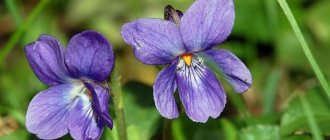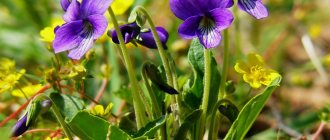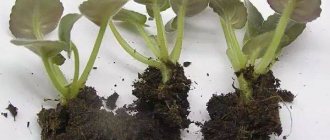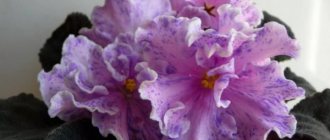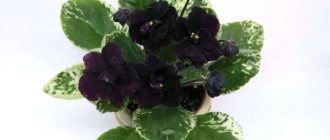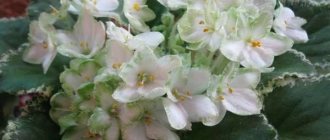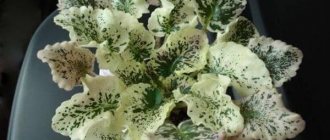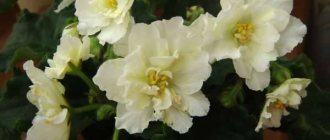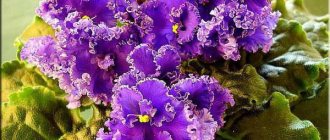The varieties of violets are striking in their diversity , as are their names. An excellent representative of this type of indoor plant is Phobos, which was named after the satellite of the planet Mars.
The color of the flowers really resembles space, and this makes the variety special and enchanting.
To obtain truly cosmic colors,
it is important to follow the rules of care and some nuances of maintenance. Otherwise, the flowers will be too ordinary, and the presence of the variety in the collection is simply useless. Next you will see a photo and description of this wonderful variety.
Violet Frosty Frolic (L. Lyon), or Frosty Frolic
This variety is an officially registered sport from the Frozen in Time variety by Sorano.
Frosty Frolic and Frozen in Time.
From time to time, Frozen in Time turns into Frosty Frolic on its own due to exposure to high temperatures or with age. Sometimes Frost Mischief starts to lighten up and resembles Frozen in Time quite a lot.
Frozen in Time shouldn't have any lavender on the petals, and Frosty Frolic has too much white. It is often very difficult to establish the boundaries between two varieties.
also a chimeric sport from the Frosty Mischief variety. It's called Frosty Morning. Also in 2006, the Ko`s Green Dragonfly sport was registered, but it is identical to the previous one.
The photo below shows options for chimeric sports.
Rosette standard , leaves are large, medium green in color with white variegation like Tommy Lowe. The leaf plate has a quilted edge.
The flower is a pansy , slightly cup-shaped. The petals are lavender-colored with a wide green border. It is worth noting that the shade of the border is a little dirty, it can even be called swamp. This combination of colors gives the variety a special charm.
A distinctive feature of this variety is its abundant and long-lasting flowering . It always blooms with a lush, beautiful bouquet, which in cool conditions can remain fresh for up to six months.
Often the period of continuous flowering lasts for a year. At low temperatures, a darker green border begins to appear at the edges of the petals.
Frosty Frolic is considered one of the record holders for the longest flowering time.
Important! The shade of the petals is maintained regardless of temperature conditions.
Violet Phobos (Regan/Croteau)
Violet Phobos was bred in 1997.
Phobos is a variety of indoor violets , a modern selection, which belongs to the genus of hybrid Saintpaulias from the Gesneriev class. Launched in 1997 by Regan/Croteau. Once on the domestic flower markets, for a long time it bore the erroneous name “Ryaba Hen”.
The socket is of a regular shape, but the size is large and standard . The leaves are heart-shaped, medium green and slightly toothed. The rosette grows quite quickly and is very well built, like a saucer. Has a tendency:
- Pull leaves;
- Or hugging the potty;
- It can also produce long stems on leaves.
The flowers are large, up to 6 cm, stars with a wavy petal edge. Fantasy color :
- Main color is lilac;
- Sometimes it has a cherry-burgundy tint;
- Spots along the perimeter of the petals range from white to pink in different shades.
Attention! It grows often, but for the most part produces either pure lilac or pink flowers. Sometimes this behavior can be observed during the first flowering, and then it can bloom according to the variety. Therefore, it is necessary to determine whether it is a sport or not after the second, or better yet, third flowering.
Caring for a plant at home
Violet is easy to care for, takes root easily, grows quickly , and produces a sufficient number of children.
He loves light very much , the better the lighting, the more lush the bouquet will be. An adult rosette can produce about 40 flower stalks at the same time .
The rosette grows quite large and requires space.
Proper watering and fertilizing
Water for irrigation must be purified using a filter or settled. Can be placed on the wick.
Also responds well to bottom watering or root watering . But it is very important to prevent water from getting on the leaves and growing point.
If the pot with the plant is located where it is very light, then watering must be done more often. The plant also requires more water during the flowering period, at high temperatures.
An adult rosette has a more developed root system and drinks much more water than a young one.
If the weather is cloudy, cool, or the substrate in which Saintpaulia grows is very dense, then water the violet much less often.
The most important aspect of plant care is proper watering. The soil should not be dry or wet, but moderately moist.
Fertilizer application begins in the third month after transplantation. The plant should take root well, the substrate should be moderately moist. also not recommended to feed weakened or diseased plants . The air temperature should be above +15°C.
It is very important to take into account that for violets with variegated leaves, choose fertilizers with a minimum amount of nitrogen. This keeps the pattern clearer and brighter.
During the development of the plant, nitrogen-containing compounds are added to the water for irrigation, and after the rosette produces flower stalks, it is fed with potassium and phosphorus.
The standard scheme involves applying fertilizers once every two weeks. But it is better to make a weaker concentration and water weekly.
Lighting and temperature
Violet should be grown at a temperature of +18-22°C . The highest temperature threshold is +25°C. But this should not be allowed, since Saintpaulia may stop flowering and even die.
Reminder on the temperature of keeping violets.
Advice! It is unacceptable to place the plant in a draft or where there are sudden temperature changes.
Air humidity
must be maintained at 55% . If the air is very humid, fungal diseases will begin to appear on the leaves. Too dry air leads to loss of decorative appearance of the outlet.
Soil composition
Soil from a flower bed or garden is not suitable for growing Saintpaulia. It is best to purchase ready-made substrates with weak acidity and add a third of perlite or vermiculite there.
In order to make a mixture for violets yourself, you should take four parts of leaf soil (under leaf trees), add one part each of sand and peat.
Pruning and hygiene
Since the violet blooms very profusely and about forty flower stalks can simultaneously bloom on one rosette, the center of the rosette is greatly darkened.
The lack of sunny color can be detrimental to the growing point, which ultimately leads to the death of the plant. For this reason, it is necessary to control the flowering process and remove some of the flower stalks from the center so that the rosette has the opportunity to fully recover.
Reproduction methods
Frosty Frolic violet is propagated by leaf cuttings. It takes root well and does not rot. Gives a sufficient number of children.
Propagation by leaf cuttings.
But it is important to take into account that the risk of genetic mutations is quite high (approximately 30%). It’s worth raising all the babies and waiting for them to bloom for the first time.
Rules for transplantation and rejuvenation
Violet grows quite slowly ; you should not replant the plant more than once a year. It is best to do this in between flowering periods. Ideally, this period will be at the end of February.
In cases where the violet stem is already large enough and resembles a palm tree or twisted into a horn, the top is carefully cut off and re-rooted, thus rejuvenating the plant.
Photo and description of violet Rob's Kaleidoscope or Kaleidoscope
The variety Robs Kaleidoscope was registered in October 1985. Retro variety .
A kaleidoscope is an optical children's toy that consists of a tube with several long mirrors inside. They are folded at an angle and display objects (most often multi-colored pieces of glass). As a result of turning the tube over, unique patterns are created.
Miniature rosette . The foliage is dark green. The leaves are small, pointed, with abundant variegation. The variegation is very stable and does not disappear at high temperatures, with age or during the flowering period.
The diameter of the rosette reaches 11 cm. The variety does not have a tendency to grow excessively . The rosette is always smooth and formed without outside interference.
The flower is a pink double star with blue fantasy touches. The pink color should be light. Can produce entire segments blue.
The foliage grows slowly , but blooms often and abundantly. The flowers are large, especially for such a small rosette.
Gives sports blue or white.
Features of maintenance and care at home
The variety is unpretentious and responds well to care. For growing, it is enough to use five. Substrate of average nutritional value without excessive amounts of organic matter.
Loves good and long-lasting lighting. Despite the fact that the variegation is stable , you should not take risks and place the violet in a dark place or overfeed it with nitrogen.
Grows and develops quickly . To get a full-fledged plant, you will have to wait about a year.
The peduncles are tall, strong, and hold the buds well in weight. The variety is not a fall plant. Gives full bouquet flowering. Propagated by leaf cuttings or flower stalks. Some children go into sports.
Caring for the plant consists of timely application of fertilizers, proper watering, and removal of lateral shoots. The variety is not a trailer, and there should be one growing point.
Reviews about violet
Elena, Zaporozhye: “A beautiful variety, a small rosette, abundant variegation and large fantasy flowers are successfully combined.
At each flowering the amount of fantasy is not the same. There are practically no problems with care. Good stress resistance." Tatyana, Samara: “The flowers are unusually large and wonderful, but the main advantage of this variety is the rosette. Very beautiful and dense variegation, forms independently and without any problems.”
Features of growth, flowering and reproduction
Violet is not capricious; it develops well at home. Takes root quickly. It takes about a year to grow a full-fledged adult plant.
Adult Frosty Frolic Rosette.
Varietal characteristics are transmitted well, but mutations occur periodically . There may be a transition to Frozen in Time or the emergence of chimeric sports.
Blooms equally in hot and cool weather. But if it’s cold, then a clearer green border appears along the edge of the leaf.
Almost always produces cap flowering. The more light, the more flower stalks.
One bud can last up to several months. Three waves of flowering often remain fresh on one rosette.
Violet Rob's Galiwinku or Robz Galvinki
The variety was registered in March 1994. Semi-miniature trailer. The foliage is dark green, glossy, slightly pointed. The rosette is neat and easy to form. Does not grow, takes up little space.
The flower is a bright lavender pansy with subtle streaks and stripes of fantasy blue splashes. The color of the flowers is always different and depends on the number of inclusions.
The size of the buds is small, but this is compensated by their quantity. Always produces a large number of peduncles , on which many buds are formed. The peduncles are thin, and you get a real waterfall of flowers. There are so many of them that the leaves are practically invisible during flowering.
It grows quickly and begins to produce flower stalks very early. It produces many stepsons; they can even form on peduncles.
Does not grow , can be kept on wick watering. Can give single-color sports. Most often the flowers have a purple hue.
Features of maintenance and care at home
The variety is very unpretentious , has good immunity and stress resistance. It does not create problems in care, it can be recommended to beginning flower growers.
Propagated by leaf cuttings. You can also root a peduncle or lateral shoot. Periodically goes into sports. It is impossible to determine a varietal plant at an early age based on secondary characteristics.
It grows and develops quickly , care is the same as for all trailer violets. It should be grown in a shallow bowl with a large diameter. When grown in three heads, it can form real flower meadows.
There are no difficulties in forming a bush. It is important to control the number of leaves and lateral shoots. Periodically, the violet should be re-rooted and rejuvenated. To do this, the head is carefully cut off, rooted in water, and planted in fresh soil.
If it is not possible to replant the plant once a year, then the top part of the soil can be carefully removed and replaced with fresh one .
Reviews about violet
Tatyana, Podolsk: “I grow two rosettes, and I like both. The sockets are very neat and compact. Despite the fact that they grow in 100 ml containers, they already produce full flowering. For growing I use vermiculite and coconut substrate. I mix in equal proportions.”
Natalia, Smolensk: “Beautiful and bright variety. I recommend it for growing. Blooms almost constantly. Each peduncle can have more than ten buds. Responds well to care."
Reviews
Tatiana, Tomsk. “This variety changes so often that it is sometimes difficult to know where Frozen in Time ends and Frosty Frolic begins. In order to preserve each variety, you should keep several copies for insurance. You never know exactly how a mature rosette will manifest itself in the next flowering.”
Violetta, Moscow. “The flowers are very beautiful, they resemble snowdrops. It responds well to care and pleases with flowering all year round. But you should carefully monitor the condition of the outlet. If the buds block the light, then the center of the rosette must be thinned out.”

